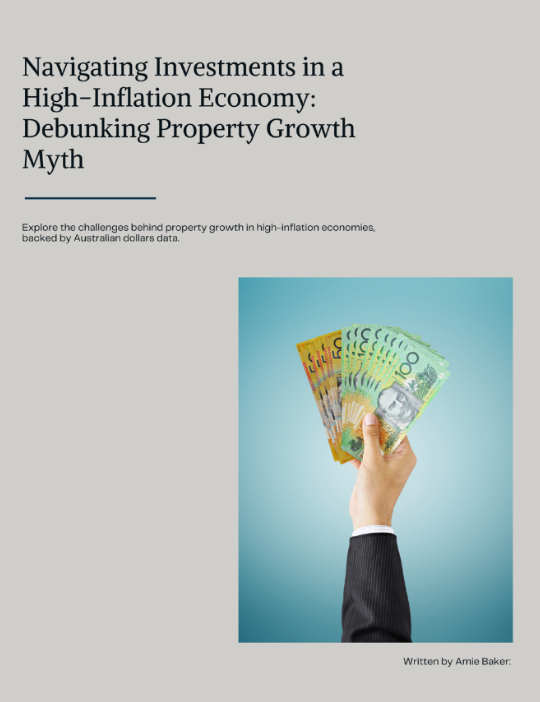As inflation remains high in Australia and the potential for further interest rate rises looms, investors face a challenging landscape. Traditional wisdom has long held that property is a surefire path to growth returns. However, in the current economic climate, it’s crucial to reassess this belief and understand the importance of creating a diversified wealth strategy.
Understanding the Current Economic Climate
Australia, like many parts of the world, is grappling with persistent inflation. The Reserve Bank of Australia (RBA) has already implemented several rate hikes to curb

inflation, and further increases are not off the table. This environment creates both challenges and opportunities for investors.
Inflation erodes the purchasing power of money, making it essential for investments to outpace inflation to preserve and grow wealth. Additionally, higher interest rates increase borrowing costs, which can affect various asset classes differently.
The Property Growth Myth
Property has historically been seen as a reliable investment, often touted for its potential to provide consistent growth returns. However, the current economic conditions challenge this notion. According to Christopher Joye, CIO of Coolabah Capital Investments and columnist for the AFR, Australian insolvencies are the worst in 25 years. Post-GFC, banks have derisked mortgage lending with borrowers shifting to non-banks. This indicates that inflation and interest rate rises are beginning to stress mortgaged property owners, potentially causing a ripple effect on property values across the country.

Risks:
- Increased Mortgage Costs: Higher interest rates mean higher mortgage repayments, which can strain the finances of property investors and homeowners. This could lead to increased mortgage defaults and insolvencies.
- Price Corrections: Rising interest rates can cool property markets, leading to price corrections. If property values decline, investors may face challenges with reduced equity and potential losses if they need to sell.
- Inflation Impact: While property can be a hedge against inflation, persistent high inflation can erode purchasing power and make it harder for renters and buyers to afford properties, affecting rental yields and demand.
The Importance of Diversification
In light of these factors, relying solely on property for growth returns can be risky. A diversified wealth strategy can help mitigate these risks and provide more stable returns. Here’s how to build one:
- Equities: Investing in a mix of Australian and global equities can offer growth potential and help hedge against inflation. Look for companies with strong fundamentals and pricing power that can pass on higher costs to consumers.
- Fixed Income*: While bonds may not provide the high returns of equities, they offer stability and income. Consider including inflation-protected securities and floating rate notes in your portfolio.
- Alternative Investments: Private equity, hedge funds, and real assets (excluding property) can offer diversification benefits. These investments often have lower correlations with traditional asset classes and can enhance portfolio resilience.
- Commodities and Precious Metals: Assets like gold and commodities can act as a hedge against inflation and provide diversification benefits.
- Cash and Cash Equivalents: Maintaining some liquidity is important, especially in volatile markets. High-interest savings accounts or short-term bonds can offer safety and flexibility.
Chris Joye’s recent article in the Australian Financial Review highlights that some of the best investments over the past financial year have been on the credit side, rather than leveraging credit for property investment. Investing in fixed income and credit products, can provide stable returns and reduce risk in a high-interest rate environment. Joye’s analysis aligns with our strategy of focusing on diversified investments that do not rely on high leverage.
Implementing a Diversified Strategy
- Regular Review and Rebalancing: The economic environment and market conditions can change rapidly. Regularly review your portfolio and rebalance to maintain your desired asset allocation.
- Professional Advice: Consider working with a financial adviser who can provide tailored advice based on your specific goals, risk tolerance, and time horizon.
- Education and Awareness: Stay informed about economic trends, market conditions, and investment opportunities. The more you know, the better equipped you’ll be to make sound investment decisions.
While property has its place in an investment portfolio, it’s important to debunk the myth that it will always provide growth returns. The current high-inflation environment and potential for further rate rises make it crucial to adopt a diversified wealth strategy. By spreading investments across various asset classes, investors can mitigate risks, enhance returns, and navigate the complexities of the current economic landscape more effectively.
Investing wisely today can help secure a financially stable and prosperous future, regardless of economic conditions. Diversification is key, and understanding the dynamics at play will empower you to make informed decisions that align with your financial goals.
For more detailed insights, you can refer to Chris Joye’s article on the best investments of the past financial year: AFR Article (https://www.afr.com/wealth/personal-finance/best-investments-of-the-past-financial-year-ranked-by-risk-20240612-p5jl2r).
Disclaimer:
This article has been written for the purpose of offering information only. This should not be treated as financial advice; your personal financial objectives have not been considered in writing this article. It is recommended that you seek professional financial advice from a Licenced financial professional prior to implementing any investment strategy.
